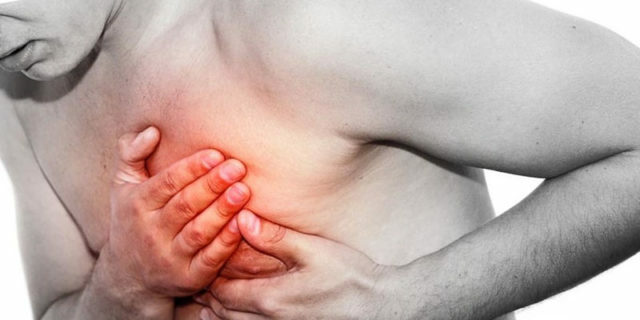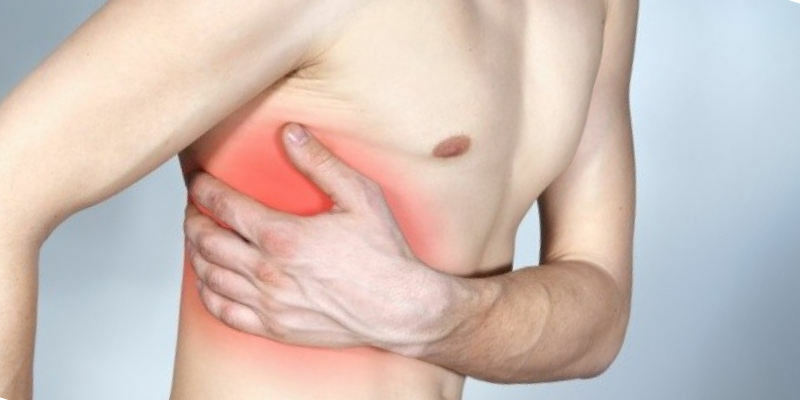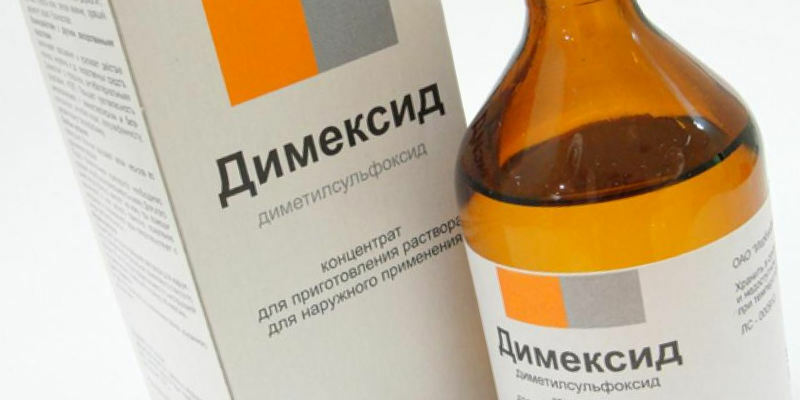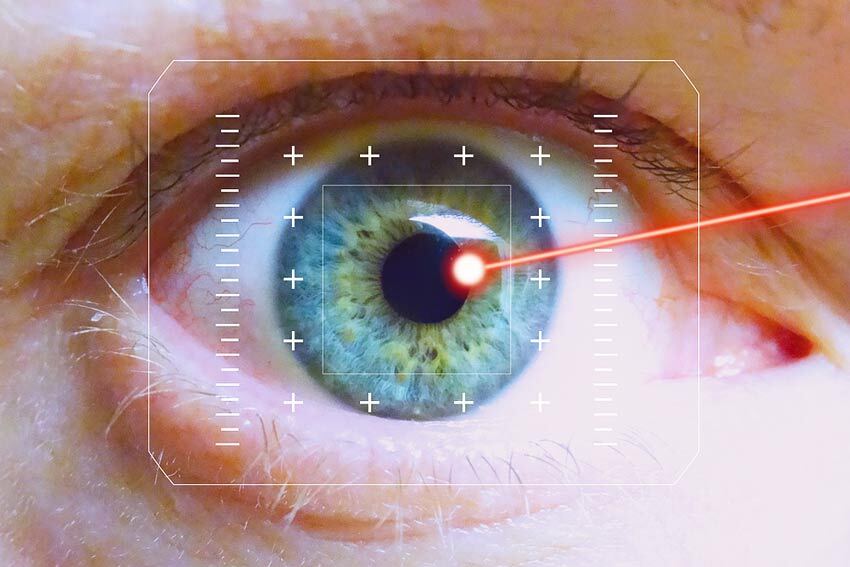
Contents of the page
- 1 Intercostal neuralgia - causes of the disease
- 2 Symptoms
- 3 ICD-10
- 4 Diagnosis
- 5 Treatment of intercostal neuralgia
- 6 Prevention
In the human body, there are twelve pairs of intercostal nerves. All of them depart from the anterior branches of the thoracic nerves, which depart from the spinal cord. Their main purpose is innervation of the skin and muscles of the chest and partly of the abdomen. The branch of the last intercostal nerve reaches the gluteal region. Intercostal neuralgia is an irritation or damage to the intercostal nerves( for example, due to the inflammatory process).
Intercostal Neuralgia - Causes of
 Disease Photo: Subcooling as a cause of intercostal neuralgia
Disease Photo: Subcooling as a cause of intercostal neuralgia There are two underlying causes of intercostal neuralgia: irritation or compression of both the nerve trunks themselves and the location of their separation from the spinal cord. To the appearance of a painful pulse due to damage to the intercostal nerves lead:
- supercooling;
- tight underwear( usually in slender women wearing bras with elements biting into the body);
- diseases of the abdominal cavity( due to common nerve plexuses, the effect of reflected pain may occur);
- long-term presence in the same position, static loads;
- sharp unsuccessful jerk;
- injury;
- is a metabolic disorder;
- stress, overload;
- age changes in the vascular system.
Neuralgic pain can be viral in nature. There are viruses that affect the nervous system, and the most common of them is herpes. The person who transferred the disease does not suspect that the virus did not disappear, but "hid" in his nervous system to activate many years later. Intercostal nerves can suffer and immediately, with the first attack of the pathogen.
Characteristics of herpetic neuralgia: pain is usually one-sided, there is an history of herpes infection, skin rashes, itching, and temperature. Sometimes herpes zoster affects the nerves that innervate the muscles;then the concomitant symptom will be muscle weakness from the same side.
Irritation of the intercostal nerves occurs for the following reasons:
- osteochondrosis( pinching of the nerve root from which the thoracic nerve leaves);
- spondylitis;
- is a tumor of cerebrospinal origin;
- hormonal spondylopathy.
All these diseases are related to the pathology of either the spine or the spinal cord. They are accompanied by compression of the initial segments of the thoracic nerves, the branches of which are intercostal trunks.
Neuralgia can also be the result of hypertonic muscle - usually the muscles of the back, shoulder blade or shoulder, from the extensor group.
A distinctive feature is the intensification of the pain syndrome with movement accompanied by stretching of the strained muscle.
Some drugs with long-term administration can adversely affect the myelin sheath of nerve fibers and provoke the development of intercostal neuralgia and other neuropathic syndromes.
Symptoms of

Intercostal neuralgia is well known in the people - it is a piercing, sharp, burning pain in the intercostal space. The expressed painful syndrome does not allow a person to breathe. Sometimes the disease is accompanied by local muscle twitching - due to impaired conductivity of the nerve impulse, increased sweating( reaction of the body to inflammation, pain), sensation of tingling in the chest, changes in the color of the skin to a pale or red shade.
There is an increase in the pain syndrome in movement, especially if the cause is muscle hypertonia, coughing, sneezing, changing position. On reception at the doctor the pain is defined palpatory - at influence on concrete points: in an intervertebral area, in an intercostal space located on a thorax.
Often, neuralgic pain radiates into the heart area, under the scapula, into the lumbar region and even under the collarbone. Numbness is noted in the lesion.
Pain in intercostal neuralgia spreads along the nerve, often have a girdling character.
ICD-10
In the ICD-10, intercostal neuralgia is classed as G58.0( otherwise "intercostal neuropathy").General group: lesions of individual nerves or plexuses.
Differential diagnosis

An important stage in the treatment of any disease is its diagnosis. A correctly diagnosed diagnosis is already half the treatment. Thus, intercostal neuralgia on the left may be similar to cardiac pathology, so a thorough examination at the stage of the patient's referral to the doctor is necessary.
The main distinguishing features of heart diseases and neuralgia:
- neuralgic pain persists for a long time, throughout the day;
- the intensity of the pain syndrome depends on the movements, breathing, coughing;it increases with palpation of the affected area;
- pain is not stopped by taking nitro drugs;
- usually there is no change in blood pressure or heart rate.
The second place is gastritis or gastric ulcer. Pain in intercostal neuralgia sharp, burning, their location - the lateral area of the chest, then with the pathology of the stomach - usually spilled, stitching, located under the left hypochondrium or epigastrium.
Ulcer and gastritis often makes itself known at night, pain is often associated with eating habits, it can be removed by taking medications that affect the acidity of the stomach. There is no characteristic of neuralgia of shortness of breath, sensation does not impede breathing.
Sometimes a picture of intercostal neuralgia can mimic pleuropneumonia, pleurisy or other pleural lesions( since the lung tissue itself can not cause pain due to the absence of nerve receptors in it).If gastritis and heart pain are simple: they usually cause pain in the left half of the chest, then the pleural damage can form a pain syndrome from either side.
Therefore, intercostal neuralgia on the right requires differential diagnosis with diseases of the pleura. Distinctive features of the latter: pain with deep inspiration( in case of neuralgia, an attack is provoked even by superficial breathing), with coughing, with a tilt to the left side, if the affected area is localized on the right, and vice versa( in neuralgia, the intensification of the pain syndrome occurs when the patient tilts to the sore side).
Other symptoms of pulmonary pathology are observed: general condition worsening, temperature rise, sputum separation. X-rays of chest organs are used for differentiation.
Do not forget about such a common renal colic. In contrast, the attack of neuralgia subsides at rest, with a decrease in the depth of breathing;depends on the movements and position of the body. Pain in colic is cramping, with neuralgia pain more often burning, acute.
Diagnosis

Diagnosis is aimed at identifying the cause of neuralgia. Its basis is carefully collected history, complaints of the patient, palpatory skills of the doctor. In most cases, these three components are sufficient for the diagnosis.
In some cases, a more thorough approach is needed - for example, with prolonged pain syndrome, which is difficult to stop with usual analgesics or frequent relapses. Both of these should lead to certain suspicions regarding the presence of a tumor or other cause of compression of the nerve root. Then the doctor is obliged to prescribe an additional examination:
- general tests of urine and blood;
- electroneurography - usually in cases where there are indications of an injury;
- electrocardiography and ultrasound of the heart - for differential diagnosis with heart disease( intercostal neuralgia on the left can simulate a picture of a heart attack);
- MRI or CT( with contrasting) to exclude the tumor process, intervertebral hernia, other pathology of the spine;
- with a history of herpes, or suspected of it - an analysis of antibodies to the herpes virus.
- Neuralgia and Pregnancy
Intercostal neuralgia during pregnancy has the same causes: inflammation, irritation, pinching of the nerve root. Pregnant women have a certain predisposition to neuralgic pain: a lack of vitamins in poor nutrition can affect the state of nerve fibers, and then the chance of developing disorders becomes much higher.
Of course, this condition, like any other, requires treatment. Unfortunately, in pregnancy, all medicines that are commonly used in the therapy of neuralgia are prohibited. Therefore, resort to a therapeutic massage, some physiotherapy techniques. Procedures should be entrusted to a specialist who does not exacerbate the situation and does not provoke complications.
It is important that the expectant mother herself performs a number of physical exercises as prevention and treatment of neuralgia. Therapeutic and sports complex is selected taking into account the individual characteristics of the woman, the gestational age, the severity of the condition, the presence of concomitant pathology.
Treatment of intercostal neuralgia
How to treat intercostal neuralgia? Therapy of neuralgia is divided into two stages: the removal of symptoms and the actual elimination of the cause that caused the process of irritation and inflammation.
Important: observe peace. In the first days of the disease recommend bed rest, while the mattress should be quite rigid. Avoid sudden movements, jerks, twists, lifting weights. Doctors advise to wear a corset during the first week of the disease, but no more so that muscle weakness is not formed.

From medical treatment use:
- anti-inflammatory drugs of the NSAID group, having analgesic effect( ibuprofen and diclofenac, piroxicam, celebrex);
- muscle relaxants( usually tolperisone, sirdalud, baclosan, tizanidine) - because in most cases the development of the pain syndrome is preceded by a muscle spasm;
- there are drugs that combine the action of muscle relaxant and analgesic( eg, myalgine);
- complex of vitamins of group B - thiamin, pyridoxine and cyanocobalamin, preferably in the form of intramuscular injections( milagamma and kombilipen preparations promote fast regeneration of damaged nerve fibers);
- if necessary - sedative drugs;
- with severe pain syndrome - dry heat to the affected area - electric hot-water bottle, mustard plaster, pepper patch, or sand heated in the pouch;
- can use a nanoplast, the mechanism of which is to use a magnetic field.
Tablets for the treatment of intercostal neuralgia should be taken strictly on time, systematically, without waiting for another painful attack. In the event that the patient has a stomach ulcer and NSAIDs, it is contraindicated, you can use ketoprofen in capsules. The capsule dissolves only in the intestines, which completely eliminates the contact of the gastric mucosa with the irritant. In this case, rectal suppositories will also be effective.
Exacerbating, severe pain syndrome is an indication for blockade with lidocaine or novocaine, compresses with dimexide.

The setting of the blockade is usually carried out by the Marev. The main indication is just the same time intercostal neuralgia. The patient lies on the back, the hand is diverted to the side. The doctor finds the edge of the pectoral muscle and the 2nd intercostal space. At the level of the second-third ribs, the skin is first anesthetized, then the needle is moved deeper to almost six centimeters and the solution is slowly injected. The drug is poured over the inner surfaces of the pectoral muscles and upward, between the stair muscles.
The location of the blockade depends on the place of manifestation of the disease, but the technique is always the same: surface anesthesia, then deep introduction of solutions. Use not only a solution of novocaine, but also anti-inflammatory drugs, for example, glucocorticosteroids.
If the disease has been going on for quite some time, all the additional causes are excluded - glucocorticosteroids are used.
In some cases, one has to resort to surgical treatment if the cause of neuralgia is the intervertebral hernia or tumor.
In the vertebrogenic nature of the disease, physiotherapy methods are recommended( UV irradiation, phonophoresis and electrophoresis with novocaine, diadynamic currents), a course of manual therapy, massage, therapeutic and physical complexes, acupuncture, laser treatment.
Important! To exclude the chronization of the disease and frequent relapses, it is necessary to carry out preventive measures, which include:
- exclusion of heavy physical exertion, lifting of weights;
- rejection of alcohol( alcohol affects the level of B vitamins, reducing their concentration);
- reduced psycho-emotional overload, stress, overwork.
If you have pain similar to the symptomatology, it is recommended to consult a doctor right away. Self-treatment, absence of examination can lead to serious complications in the event that you misinterpreted the clinic of the disease.
Home Treatment

Treatment of intercostal neuralgia at home is undesirable for the above reasons. However, in some situations( the disease was taken by surprise, and the hospital is too far away, or to the neurologist a queue length of a month), this is possible. To do this, you need to know the symptoms and treatment of intercostal neuralgia.
Thoroughly analyze the clinical manifestations: try to make sure that the pain is caused by intercostal neuralgia. At the slightest doubt it is better to consult a doctor.
If you are sure of the reason for your condition, follow these guidelines:
- Peace. Strict bed rest, minimal motor activity is necessary. This will help to avoid unnecessary irritation of nerve fibers.
- Dry heat. Heat will eliminate muscle spasm and eliminate pain syndrome. If you do not have a heating pad, use any improvised means: freshly cooked and wrapped in a towel egg, sand in the bag, dry mustard powder, pepper plaster. If pain is localized in the heart, heat can not be applied! If there is nothing of the indicated means, a warm woolen scarf or sweater will do.
- Warming ointments are suitable - apply them in a small amount to the painful area. Take any anti-inflammatory non-steroid drug that is found in the medicine cabinet. If there are candles, use them better.
- You can use folk remedies: smear the affected area with horseradish or radish juice, apply steamed and wrapped in cloth flax seeds.
- A therapeutic bath with sea salt and sage can relieve pain. Prepare an infusion of sage( 4 tablespoons per 200 ml of water pour boiling water, insist an hour).Fill the bath with water at a temperature of 37-38 degrees, pour into it infusion and add sea salt in a volume of 50-60 grams. The duration of the procedure is ten minutes. It is better to take a bath for the night. After rubbing the body to dry, put on warm, woolen things.
- Excellent means - acupressure. Pain can be eliminated by exposure to two bioactive points. One of them is between the bases of the fourth and fifth toes of the foot( on both sides) - it is pressed three times, one minute. The pressure should be a thumb pad.
The second point is located at the base of the fourth finger of the brush. Before the massage, carefully untangle the ring fingers.
Prevention of

To avoid recurrence of an attack, neuralgia is recommended to follow simple rules:
In a timely manner, treat problems with the spine;
- Do physical exercises, warm up after a long time in the same position;
- Avoid stress;
- At the computer and in the office, try to keep your back straight, keeping your posture;
- Choose an armchair that is comfortable in terms of orthopedics, if your work is mostly sedentary.



